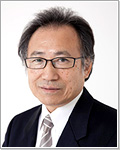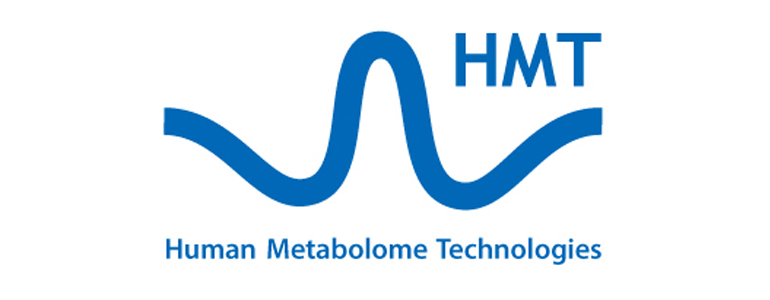| Human Metabolome Technologies (6090) |
|
||||||||
Company |
Human Metabolome Technologies Inc. |
||
Code No. |
6090 |
||
Exchange |
Mothers of Tokyo Stock Exchange |
||
Industry |
Service Industry |
||
President |
Ryuji Kanno |
||
Address |
246-2 Mizukami, Kakuganji, Tsuruoka-city, Yamagata |
||
Year-end |
End of March |
||
URL |
|||
*Share price as of closing on the end of June 7. Number of shares outstanding is as of March 31.
ROE and BPS are based on actual results of the previous term end. |
||||||||||||||||||||||||
|
|
*Forecasts are those of the Company. From the current fiscal year, the definition for net income has been changed to net income attributable to parent company shareholders (Abbreviated as parent net income).
|
|
| Key Points |
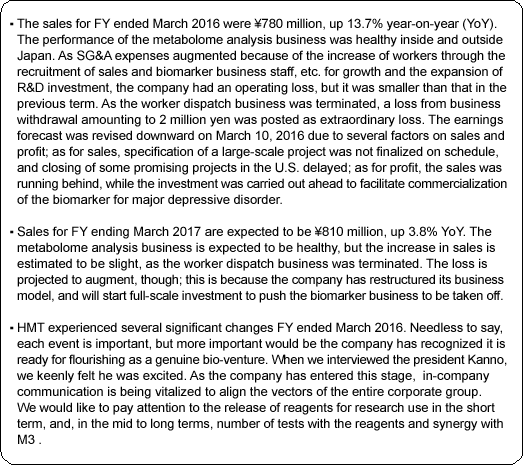 |
| Company Overview |
 Metabolome analysis techniques had been used for various purposes such as fundamental biological research, development of pharmaceutical products, disease biomarkers, etc., and were expected to expand the demand in the future. Therefore, upon establishment of the CE-MS system, Human Metabolome Technologies Inc. was established in July 2003 to commercialize the method chiefly by Professor Soga, Professor Masaru Tomita, also from Keio University, and the office of Keio University. It was the first venture company originated from Keio University, with a financial support from Keio University's entrepreneurship fund. In 2008, Mr. Ryuji Kanno became the president of the Company. Before taking up this position, Mr. Kanno who was the Vice President & CEO of Agilent Technologies Japan, Ltd., a Japanese subsidiary of Agilent Technologies, a global company that develops, manufactures, sells, and supports chemical analysis equipments and electric & electronic measurement equipments in the field of life science., which, had been for some time in business relationships with HMT and Keio University. President Kanno promoted research and development of the Company's core technologies and also began organizing and establishing more specific commercialization process and business models. At the same time, he began preparation for the Company to be listed on the stock market in order to accelerate its growth speed through enhancing the Company's visibility and raising funds for research and development. The Company got listed on the Mothers Section of the Tokyo Stock Exchange in December 2013, ten years after its establishment. "To contribute to people's health and joyful lives through research and development using the up-to-date metabolome analysis technologies for children in the future." 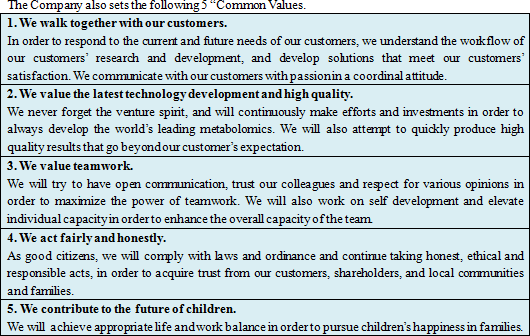 ① Significance of Social Presence
Biomarkers are in vivo substances that are used as indicators to assess current state of specific diseases. Blood sugar" for diabetes, "γ-GPT" for liver function disorder, and "uric acid" for gout. are representative examples of well-known and widely used biomarkers.The Company discovered a biomarker for "major depressive disorder", one of current major social issues, and is developing diagnostic agents to quantify the condition of the disease. Because there is no prevailing method to objectively measure the status of depression although the number of patients of depression is increasing, some serious problems are emerging regarding to the therapy of depression. For example, patients who would have been cured if they had properly treated are still suffering or in overprescription. If the diagnostic agents using the Company's biomarker become to be widely used, these issues are expected to be solved, and social loss will be subsequently reduced.This social significance cannot be overlooked to understand the Company. ② Excellent Technological Capacities
The Company is highly recognized thanks to the "metabolome analysis technology" which is used to examine complicated behavior of metabolites in human bodies to identify biomarkers. The biomarker for depression is just an example. With the technology, the Company is expected to identify and develop various new biomarkers in the future. ③ Stable Business Model
The Company's current core business is the "commissioned metabolome analysis business", supporting research and development activities of research institutions and pharmaceutical companies, that occupies about 80% of its sales. Sales of FY March 2016 were 703 million (up 13.4%, YoY) and operating income was 300 million (up 30.1%, YoY), showing steady income. On the other hand, the "biomarker business", which is expected to achieve significant growth in the mid- to long-term, is still operated in a small scale and experiencing losses. However, the Company has already established a balanced business model, in which the profit generated from the commissioned metabolome analysis business is invested into the biomarker business for its growth. This model is notable among many bio-venture companies that are suffering from gaining profit. ◎What is Depression?
Depression is a type of mood disorders, and is a brain dysfunctional state for various reasons such as accumulated physical and mental stress. Because the brain is not functioning properly, people in the depressed mood feel negative and low-esteem. This causes vicious cycle in which people with depression feel more stress for matters that they could otherwise handle. The "major depressive disorder" refers to the state in which depression mood continues even after the sources of stress are removed. In this regard, it is distinguished from adjustment disorders or some anxiety disorders, and is considered a brain dysfunction, instead of a mere response to stress. (Note: "Major" of the major depressive disorder means "primary" and does not mean "serious" depression.) ◎Number of depression patients in Japan
According to the "Patient Survey" conducted by the Ministry of Health, Labor, and Welfare (MHLW) every three years targeting health facilities across the country, the total number of patients with mood disorders including depression increased from 430,000 in 1996 to 950,000 in 2011 (2.2x). The "Patient Survey" shows statistical data of the number of patients who visit health facilities. It is known that the consultation rate of patients with depression is low. Thus, according to the MHLW, it is suspected that the actual number of depression patients might be larger.
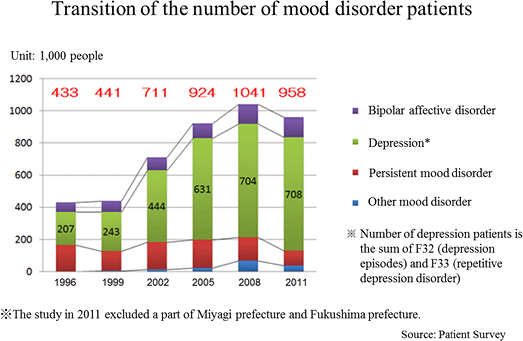 ◎Treatment of Depression
If someone is diagnosed as having depression, the common treatment is prescription of "antidepressant drugs." The antidepressant drugs can be categorized into several groups such as selective serotonin reuptake inhibitor (SSRI), serotonin-noradrenaline reuptake inhibitor (SNRI), and tricyclic antidepressant. In addition, anti-anxiety drugs or sleep inducing drugs can be used, depending on the symptom. The important thing under drug therapy is that the patients comply with the prescribed amount and frequency after they are informed the effects and side effects. However, patients with depression often reduce the amount or frequency without doctors' permission as they do not feel the symptom to be very serious, they worry side effects, etc. In these cases, the patients do not show improvement as doctors expect, and the doctors prescribe more drugs or change the types of drugs. That would often result delay in recovery or excessive administration of drugs, for lack of trust between doctors and patients. Therefore, it is essential to have objective assessment standards quantifying the state of depression or proving the depression has been cured. The biomarker and diagnostic agents of the depression that the Company is currently working on are extremely important for prompt and appropriate treatment of the disease. <What is metabolomics?>
Living organisms including human beings consist of some parts with various functions such as muscles, internal organs, and bones. "Metabolites" such as amino acids, fatty acids, and nucleic acids are common and major components of these organs. Metabolites play crucial roles for entire life activities. Metabolites are provided by food, and are consumed in the process of daily actions such as exercise. They move in a body and cells in accordance with their functions, and are converted into new substances through various chemical reactions, which are called "metabolism". Adjusting body temperature, breathing, moving heart, digesting and absorbing food, transforming old cells into new ones are all operated by metabolism. The "substance conversion" to a new substance is based on a certain flow called metabolic pathway. One of well-known approaches to understand mechanisms of a human body is "genomics", analyzing genes. Now, automated sequencing and computer analysis of genetic information (DNA base sequences) is available, and nearly all the information in the human genome has already been deciphered. However, much about the relationship between the roles of genes and diseases remains unknown. Recently, more researchers lean towards investigating metabolic profiles, in addition to genetic information coming out of genome analysis, in order to understand the relationships between a human body and diseases. Consequently, research and use of "metabolomics (metabolome analysis)" targeting all metabolites is becoming increasingly popular.  <What are biomarkers?>
A human body puts various vital functions under high-sophisticated manipulation to minimize internal and external influences, and subsequently keeps the body condition stable. That mechanism is called "homeostasis". For example, body temperature and heartbeat may change temporarily, but return to regular ranges. Diseases lead abnormal homeostasis and metabolic status, which are different from healthy conditions. A metabolite, which concentration keenly reflects status of a specific disease, is called a biomarker. By measuring a biomarker, the current status of a specific disease can be objectively assessed. Blood sugar as a pancreas function indicator, γ-GTP as a liver function indicator, biomarker PSA for prostatic cancer and biomarker CA19-9 for pancreatic cancer are examples of well-known biomarkers. Biomarkers have been studied for a long time in order to monitor the status of diseases. These days, with new methods to analyze multiple substances with higher sensitivity all at once, study results of various new biomarkers have been publishing one after another. Among the biomarkers that are explored through metabolomics technologies are the followings:  Previously, the company allocated the profit from the "metabolome analysis business," which is the current mainstay business, to the investment in the R&D of the promising "biomarker business," and applied the intellectual property obtained through the R&D to the development of medicines and disease diagnosis, with the goal of growing in the mid to long terms. From the term ending Mar. 2017, the company will accelerate the investment in the biomarker business by procuring funds from the outside in order to flourish in the future. 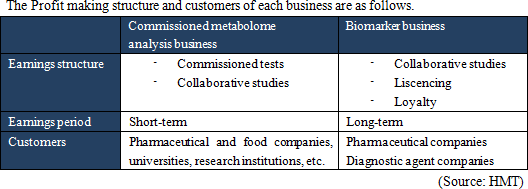 ① Commissioned Metabolome Analysis Business
The Company receives orders from various customers, e.g., private companies such as pharmaceutical companies and food companies as well as universities are public research institutes."Sales were ¥703 million and operating income was ¥300 million for FY March 2016." The scheme of the service is as follows. A costumer sends samples to the Company, and then metabolites are extracted from the samples. The extracted metabolites are measured by the CE-MS system, and the acquired data is analyzed. After all, the report is delivered to the customer. The data obtained from the service are used for various purposes; basic biological study, assessment of drug effectiveness and toxicity assessment by pharmaceutical companies, universities, and research institutions, analysis of fermentation process and functional evaluation of functional foods by food companies. The data is contributing to the progress of research and development activities of customers. ◎Deployment in the Overseas Market
In order to offer the commissioned metabolome analysis service in Asia, the Company concluded an exclusive sales authority agreement with Young In Frontier Co., Ltd. in South Korea in June 2011. Moreover, the Company is endeavoring to develop Asian market including Singapore and Hong Kong, outside of South Korea through hiring a sales representative in charge of Asia-Pacific area. Furthermore, in order to expand its business in the North American market, it also established its sales subsidiary, Human Metabolome Technologies America, Inc., in October 2012 at Cambridge, Massachusetts, USA, home to many medical research institutions.
◎"C-SCOPE" -a service package of the commissioned metabolome analysis service for cancer study
In August 2012, the Company launched "C-SCOPE", a service package of the commissioned metabolome analysis service well organized for cancer study. C-SCOPE was developed to respond to the needs; they would like to measure concentrations of specific metabolites changing inside cancer cells with higher sensitivity and higher accuracy. Its technologies are based on unique and efficient metabolites extraction method from cancer cells and highly sensitive analytical system.Cancer is the number one cause of death in Japan since 1981 and occupies about 30% of the recent total causes of death. According to the MHLW, the costs for cancer research are increasing year by year; in 2012, ¥35.7 billion were spent. It is an urgent task for many pharmaceutical companies to develop effective new anticancer drugs. The "Warburg effect" is the phenomenon that most cancer cells have glycolytic rates of several to dozens of times to that of normal cells. Although this effect was proposed as far back as over 80 years ago, the research on the effect made little progress since there was no method to comprehensively measure metabolites back then. Thanks to the dramatic advancement in metabolomics technologies in recent years, development of anticancer drugs which act as metabolic inhibitors are underway. The Company's metabolome analysis technology based on the CE-MS system is considered as one of the effective analysis systems applicable at each stage of cancer research; from basic study of cancer biology to clinical application in the process of anticancer drugs development. ②Biomarker Business
The Company considers the business related to biomarkers, which play an important role in occasions such as early diagnosis or monitoring treatment effects, as a driver for future growth, and is proceeding with biomarker discovery and development of clinical test drugs through collaborative research and development with universities, pharmaceutical companies, and diagnostic drugs companies. "Sales was ¥31 million and operating loss was ¥60 million for FY March 2016" The Company develops new diagnostic methods by using biomarkers, which were acquired through its own R&D, or biomarkers introduced from outside. Additionally, through the process of product development and clinical development, the Company produces and sells in vivo diagnostic drugs and diagnostic equipment. The sales in this business are composed of cooperation money for R&D from pharmaceutical companies in cooperative research, milestone revenues, and loyalty gained from the sales of the drugs when they are commercialized. ◎Intellectual Property Policy
The personnel in charge of intellectual property and contracts work on patent application and request for examination of all projects, and are in close collaboration with the patent attorneys of the Company and its collaborative research institution. They are also responsible for negotiation concerning collaboration research agreements and development of agreement documents. The Company attempts to maximize its rights when obtaining a patent of newly discovered biomarkers. Since the scope of the rights differs depending on the marker, the Company generates patent application documents in a way that would cover wide scope of the rights such as chemical structure of the biomarker, usage for diagnostics and drug development, detection method and measurement equipment. Furthermore, the Company makes it a principle to file international patent applications in accordance with the Patent Cooperation Treaty, in anticipation for the future license agreement and market based on the information of clinical test drugs, test equipment companies and pharmaceutical companies of various countries. ◎Example of Biomarker Business: Depression Biomarker
The Company especially focuses its research and development on a) the central nervous system disorder such as depression (e.g. mood disorder, and mental disorder) for which there are few objective diagnosis methods b) diseases that have become a social problems such as metabolic syndrome, including hepatitis and diabetes, and their related diseases. Its current focus is the biomarker for depression. Diagnosis of major depressive disorder is conducted using the diagnostic standards provided by the American Psychiatric Association or the standards of the World Health Organization (WHO). However, both of them largely reflect the subjective view of the doctor or patient, and unlike other diseases, no diagnostic method has been established on the basis of objective indicators. The Company conducted collaborative research with the National Center of Neurology and Psychiatry, and discovered a blood biomarker of major depressive disorder. Blood samples were collected from approximately 30 patients and 30 healthy people, and the blood components were compared through metabolome analysis using the CE-MS system. As a result, the patients with major depressive disorder showed lower concentration of phosphoric ethanolamine (PEA) in their serum. Through further analysis, it was found that a) PEA is a specific biomarker for major depressive disorder, and b) PEA level will return to the healthy standard range when MDD is treated. 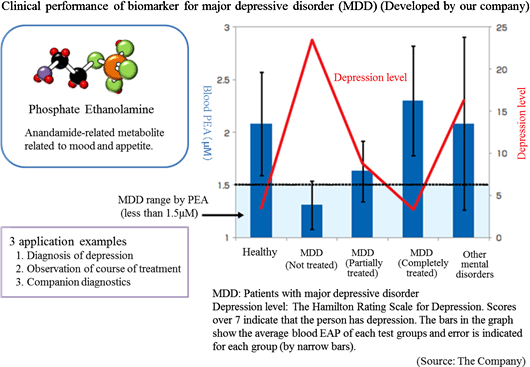 *Companion diagnostics: Refers to clinical tests to predict effects and side effects of pharmaceutical products before administration. By checking the responses of individual patient towards a drug before treatment, more effective drug administration can be provided.
◎Identification of Disease Biomarkers
The Company uses the following three connections and systems for identifying biomarkers in order to expand biomarker development pipelines.
<Connection with the Customers for Commissioned Analysis or Collaborative Development>
The Company accepts requests from universities and companies for the tests for finding biomarkers. The Company also receives proposals for collaborative development before or after the tests. Currently, a collaborative development project for diabetic nephropathy biomarkers is ongoing.
<Direct Proposal to Researchers and Physicians>
The Company's researchers directly propose research plans for the development of disease biomarkers to researchers or physicians, and establish collaborative study agreement with the institution based on approvals from the collaborative researchers or physicians. The target diseases are chosen according to the number of patients, compatibility to the analysis technologies of the Company, degree of social contribution, and necessity of biomarkers. In addition to major depressive disorder, the Company is working on the development of biomarkers for non-alcoholic steatohepatitis and fibromyalgia.
<HMT Research Grant for Young Leaders in Metabolomics>
The Company offers a grant (HMT Research Grant for Young Leaders in Metabolomics) to graduate students to disseminate the usefulness of metabolomics in the society and nurture young researchers. From the research themes submitted from graduate students across the world, the Company chooses excellent proposals, and supports their research by awarding metabolome analysis service without a fee. Fourteen students have been awarded in the last 4 years. Some of these study results actually led to identification of biomarkers and evolved to collaborative study with the Company, for example, infectious disease-related encephalopathy biomarker.
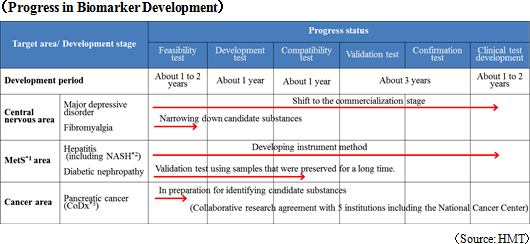 |
| Fiscal Year March 2016 Earnings Results |
 Sales increased, but the company had a loss due to the augmentation of investment for growth.
Sales were 780 million yen, up 13.7% year on year. The performance of the metabolome analysis business was healthy inside and outside Japan. As SG&A expenses augmented because of the increase of workers through the recruitment of sales and biomarker business staff, etc. for growth and the expansion of R&D investment, the company had an operating loss, but it was smaller than that in the previous term. As the worker dispatch business was terminated, a loss from business withdrawal amounting to 2 million yen was posted as extraordinary loss. The earnings forecast was revised downward on March 10, 2016 due to several factors on sales and profit; as for sales, specification of a large-scale project was not finalized on schedule, and closing of some promising projects in the U.S. delayed; as for profit, the sales was running behind, while the investment was carried out ahead to facilitate commercialization of the biomarker for major depressive disorder.  Operating income grew 30.1% year on year to 300 million yen. Both sales and profit increased from the previous term, but did not reach the initial estimates, partially because specification of a large-scale project was not finalized on schedule.  "Situation of Depression Biomarker-based Examinations"
The Company is currently operating or developing two types of depression diagnoses based on the biomarker. One is entrusted PEA examination by "ion chromatography ." In the previous FY, the Company started up the entrusted clinical depression test by ion chromatography in cooperation with specialized hospitals in order to improve awareness of the depression biomarker and open up more business opportunities for charged tests. However, it was found that the measurement and sample transportation are more time and cost consuming than expected, and the company has been working toward a solution utilizing external resources. The other is depression blood test kit by "Enzyme Method" which is being commercialized in collaboration with Sysmex. A low-cost and high speed measurement is essential to diffuse depression diagnoses based on the biomarker and the test kit makes it possible. The company has been constructing its own development system in parallel with the commercialization with Sysmex, and the original research-use reagent is expected to be released in the market by the end of fiscal 2016. The company plans to offer this reagent not only for large testing facilitates owned by large hospitals, clinical examination centers, etc., but also for mental clinics run by individual specialists. Development of a bench-top instrument which enables on-site measurements is ongoing along with it. The company considers awareness to the kit will rise up by creating as many opportunities that doctors access to the kit. 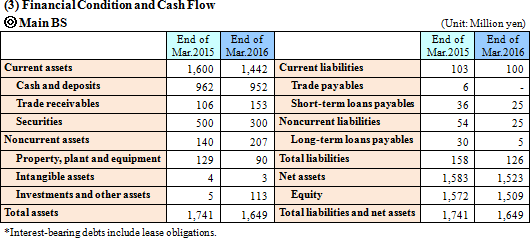 Consequently, equity ratio rose from 90.9% at the end of the previous term to 92.3%.  Investing CF declined, as the company obtained investment securities although the purchase of property, plant and equipment dropped. Financing CF dropped, as the income from the issuance of shares through the exercise of share acquisition rights decreased. The cash position declined. |
| Fiscal Year March 2017 Earnings Estimates |
 Sales increased slightly, but losses augmented through enhanced prior investment.
Sales are estimated to grow 3.8% year on year to 810 million yen. The performance of the metabolome analysis business is expected to be healthy, but the discontinuance of the worker dispatch business will affect sales. Then the increase in sales is forecasted to be slight. Losses will augment, though; this is because the company has restructured its model, and will start full-scale investment to push the biomarker business to be taken off.(For the details and background of this matter, please see Section 4 "Interview with the President Kanno.") 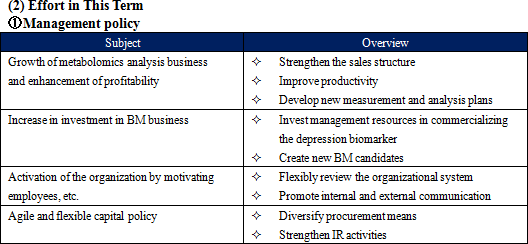  External environment remains healthy
In Japan, market categories are being created in conjunction with enforcement of the Food Functionality Labeling System and strengthening of international competitiveness through participation in TPP.In addition, the environment surrounding this business remains healthy thanks to propelled realization of proper self-medication to reduce medical expenses, increase in budgets for fields that will lead to health and longevity as well as fields of research into preventative medicine, advancement in support for new medicine creation and development of innovative medicines, etc. through establishment of the Japan Agency for Medical Research and Development (AMED), strong need for early detection, diagnosis and treatment development against mental disorders such as dementia and Alzheimer's disease, and so on. Furthermore, budgets for cancer research such as a "Cancer Moonshot" are rising in the U.S. Effort in this term
Under such circumstances, HMT will expand its business operations through the following sales and marketing activities:
Acceleration of overseas expansion
In the U.S., sales activities will be enhanced to get orders mainly in academia and clinical biomarker projects. In addition, HMT will enter the markets in the West Coast, and will start exploring markets in European countries in this term. Regarding the Asian markets, it will propel expansion of its business into the markets in Singapore, Taiwan, Hong Kong, and China.
Obtaining large-scale projects and package contracts
HMT aims to take part in 6 projects with regard to clinical biomarker exploratory trials and cohort studies. It aims to conclude 5 package contracts on an annual basis. In addition, it plans to release a new service for clinical biomarkers.
 Investment is accelerated in conjunction with a change in the business model.
For greater success in the future, HMT decided to change the business model of its biomarker business from the "Research and Development & Licensing-out style" to the "Research and Development & Production and Sales style."In conjunction with that, although, conventionally, the company sought to expand its biomarker business by investing profit made in the metabolomics business into the biomarker business, from this term onward, it decided to further accelerate investment in the following fields not only with profit from the metabolomics business but also with funds raised separately. Therefore, the range of loss will be much greater than the previous term; however, it is vital to thoroughly understand such grounds for the augmentation of loss.  (3) Topics
For HMT that decided to develop the "Research and Development & Production and Sales style" business, the immediate priority is to put into practical use and commercialize depression biomarkers early, and it is required to make the aforementioned investment in research and development more proactively.◎ Implementation of third-party allocation of shares In addition, HMT formed a business alliance with M3, Inc. (hereinafter referred to as M3) to accelerate practical realization and commercialization of the biomarkers, and conducted third-party allocation of shares with the allotment date set on June 10, 2016 to establish a cooperative relationship in conjunction with the acceleration and make the shareholder composition more stable. 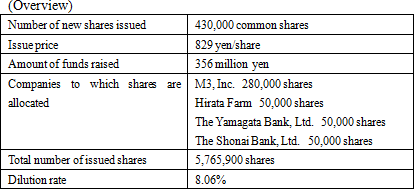 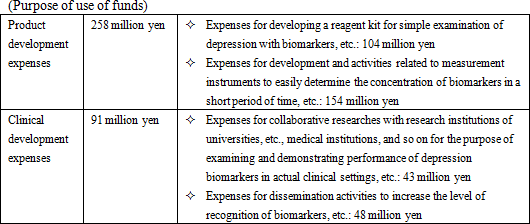 ◎ A capital and business alliance agreement was concluded with M3.
HMT entered into a capital and business alliance agreement with M3, one of the companies to which shares are assigned, in May 2016.
<Background to the alliance>
M3 runs "m3.com," a website targeting especially at health professionals on which about 250,000 doctors are registered as members. Through "m3.com", it provides marketing support services for pharmaceutical companies such as "MR-kun", an online platform for doctors offering information concerning medicines etc. and clinical trial support services chiefly with "Chiken-kun," that searches for facilities which will participate in clinical trials and subject patients, and so on. In addition, one of its subsidiaries provides support for establishing development strategy on new drugs and medical equipment, etc. These business activities make M3 one of the representative companies in Japan that widely expands its business in the medical industry with the use of the Internet.HMT determined that it is able to not only accelerate commercialization of the depression biomarker by taking advantage of overall capabilities of the M3 group and strengthening cooperation but also maximize its value as a biomarker development platform by exploring for new biomarker pipelines. <Details of the capital alliance>
M3 receives about 230 million yen from the aforementioned third-party allocation of shares. It has become the second largest shareholder with a voting rate of about 4.9%.
<Expected synergy effect>
In the future, regarding HMT's biomarker business, synergies will be pursued by having further discussion between the 2 companies on the following cooperation:
STEP1 : Cooperation in seeds research
Productivity regarding HMT's biomarker seeds research will be dramatically improved by collecting ideas and seeds of biomarkers from doctors in the actual medical settings through efficient use of the research platform of m3.com.
STEP2 : Cooperation in development
Commercialization of HMT's biomarkers will be accelerated by taking advantage of resources to support clinical studies and clinical trials provided by M3 and its group companies (such as pharmaceutical consultation, CRO, and SMO).
STEP3 : Cooperation in sales
Market research and analyses regarding commercialization of depression biomarkers which HMT is currently developing, improvement of recognition degree and increase in the number of medical institutions which introduce the biomarker, sales expansion, etc. will be propelled through effective use of marketing support resources of the M3 group such as the "MR-kun." In addition, M3 will support global expansion of the depression biomarkers in the future.
STEP4 : Possibility of joint business
In the future, HMT will aim to seek to expand biomarkers made in Japan into global markets by centralizing management resources of both HMT and the M3 group, searching for potential for development of joint business such as collaborative development or joint sales of biomarkers and cooperative acquisition, and effectively using the platforms of the M3 group all over the world.
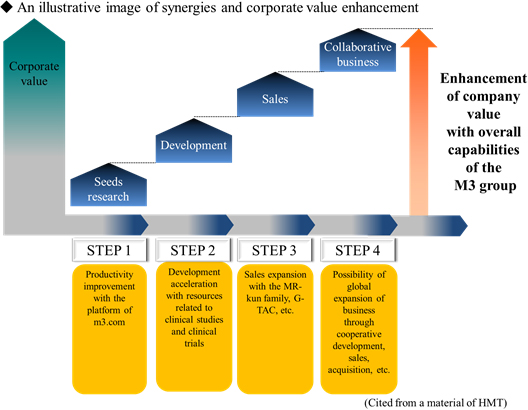 |
| Interview with President Kanno |
|
"We shifted our biomarker business to the "Research and Development & Production and Sales style" one. The previous term was the year of innovation to our company."
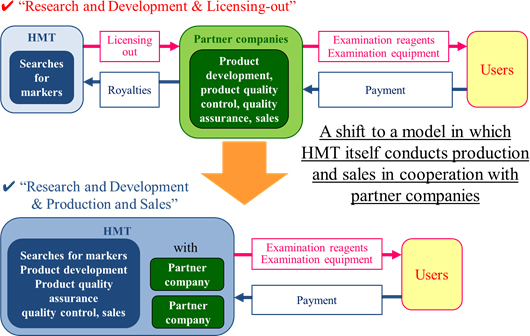 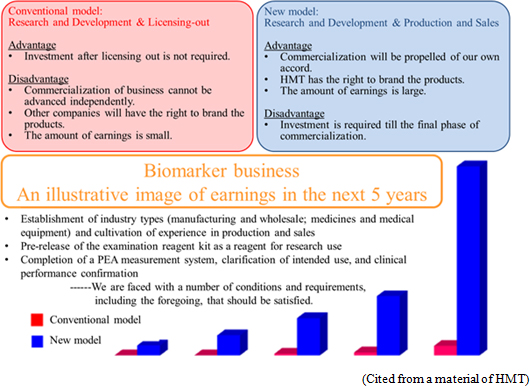 "The biomarker business is about to take off, making the steps toward monetization specific."
"Investment has been accelerated and an alliance was concluded to create a presence in large markets."
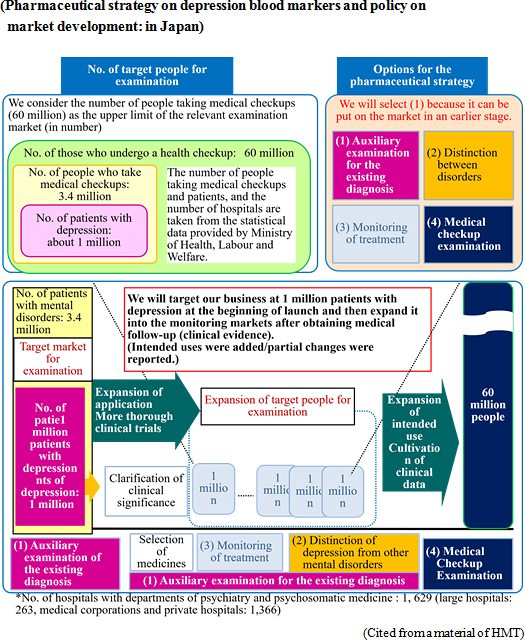 |
| Conclusions |
|
We would like to pay attention to the release of reagents for research use in the short term, and, in the mid to long terms, number of tests with the reagents and synergy with M3 . Disclaimer
This report is intended solely for information purposes, and is not intended as a solicitation for investment. The information and opinions contained within this report are made by our company based on data made publicly available, and the information within this report comes from sources that we judge to be reliable. However we cannot wholly guarantee the accuracy or completeness of the data. This report is not a guarantee of the accuracy, completeness or validity of said information and opinions, nor do we bear any responsibility for the same. All rights pertaining to this report belong to Investment Bridge Co., Ltd., which may change the contents thereof at any time without prior notice. All investment decisions are the responsibility of the individual and should be made only after proper consideration.Copyright(C) 2016 Investment Bridge Co., Ltd. All Rights Reserved. |

